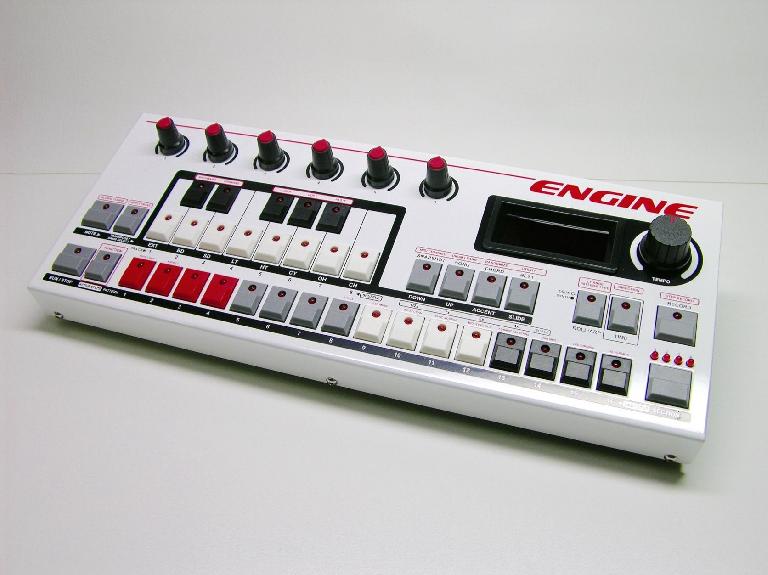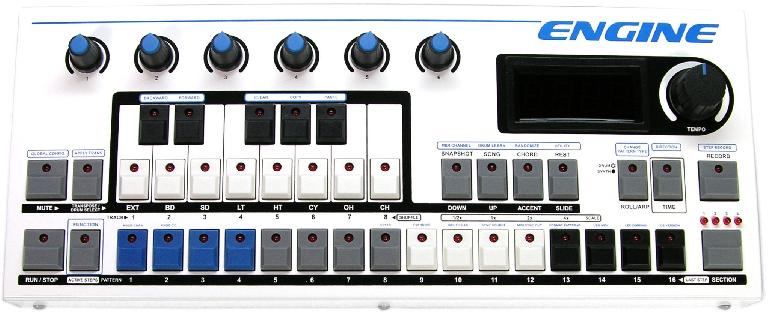Allen, TX USA - Social Entropy announces the immediate availability of ENGINE hardware sequencer. ENGINE can be ordered directly from http://www.socialentropy.com for $665 USD (plus shipping and any applicable local taxes and fees). ENGINE is available in two color schemes, red/white or blue/white.
ENGINE is a polyphonic hardware step sequencer for pattern based music composition and performance. ENGINE provides a dedicated interface for creating melodic and percussion patterns in a compact tabletop unit.
ENGINE can be used for sequencing MIDI based devices using standard MIDI or USB- MIDI, and with an optional 16 output CV expansion board, ENGINE can interface with modular synthesizers and other analog devices.
ENGINE can sequence eight simultaneous tracks. Timing for each track is independent, with only a shared master clock across patterns, allowing simultaneous patterns of varying lengths and meters. Each pattern can be up to 64 steps in length with eight timing scales, multiple levels of shuffle, directions and the ability to skip individual steps. Up to 16 patterns can be chained for extended length sequences.
ENGINE contains 512 patterns which can be either synth (melodic) type or drum type. Synth type patterns allow for polyphonic programming with dedicated accent, slide, delay, repeat and transposition and also include a built in arpeggiator. Drum type patterns allow for eight instrument polyphony, with dedicated accents, delay, per instrument repeats, instrument muting/soloing and a drum roll mode.
The sequencing engine supports simultaneous grid, realtime and step recording. Allowing realtime performances to be captured with the built in mini-keyboard or via MIDI controller. In addition, the arpeggiator, drum rolls, slides, accents and transposition can also be recorded directly into a sequence in realtime.
Functions like copy and paste, randomize, rotate and reverse can be applied to entire patterns or to individual drum instruments. All operations can be performed without stopping the sequencer. All settings are stored in non-volatile memory.
For constructing songs, snapshot and song modes allow the current state of all tracks to be captured and recalled with a single button press. 32 songs can be recorded in realtime or by step programming.
Six general purpose controller knobs can be mapped to any MIDI controller message and MIDI channel, or follow the selected track. This makes it possible to tweak devices directly from ENGINE. The knobs also control an interactive MIDI effects system that add ratcheting, delay, velocity and gate offsets per track.
Watch an overview of Engine from when it was first announced in February 2015:
The optional CV expansion board (available soon) adds sixteen analog outputs that can be used in multiple modes to provide pitch CV, gate, triggers, clocks and auxiliary voltages. A hardware slide circuit produces smooth CV output for programmed slide events. CV voltage range from -3V to +7V with +10V gates allows full range control over analog devices. The CV expansion also allows ENGINE to function as a standalone 8 channel MIDI to CV converter operating in either monophonic or polyphonic mode
Synchronization can be via internal clock, MIDI clock or DIN sync (master or slave). MIDI System Exclusive support allows pattern data to be dumped to external devices for backup or sharing.
USB connectivity via an isolated USB port eliminates grounding problems and is also used for easy operating system upgrades.
For more information, please visit http://www.socialentropy.com






 © 2024 Ask.Audio
A NonLinear Educating Company
© 2024 Ask.Audio
A NonLinear Educating Company
Discussion
Want to join the discussion?
Create an account or login to get started!